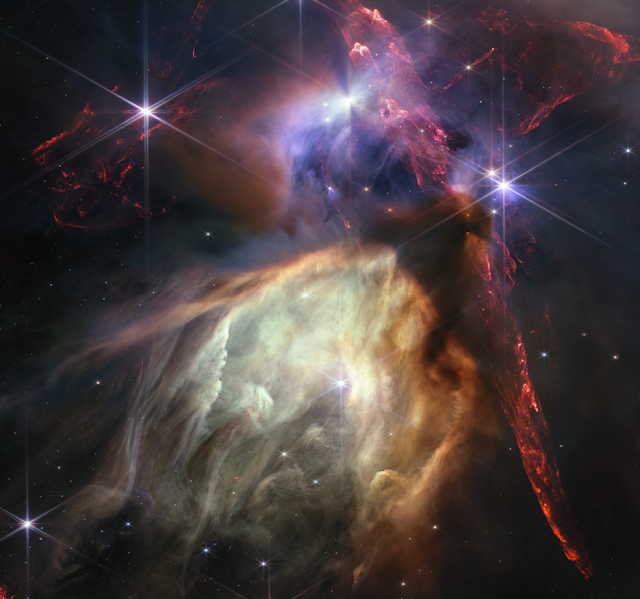• The first anniversary image from NASA's James Webb Space Telescope depicts star birth in unprecedented detail and impressionistic complexity. The Rho Ophiuchi cloud complex is the closest star-forming area to Earth. It's a modest, calm stellar nursery, but Webb's hectic close-up would have you believe otherwise. Jets erupting from young stars crisscross the image, interacting with the surrounding interstellar space and illuminating molecular hydrogen (seen in red). Some stars cast the telltale shadow of a circumstellar disk, which contains the seeds of future planetary systems.
 |
| Credit goes to NASA |
• Many of these disks include young stars with masses comparable to or smaller than the Sun. The star S1 is the largest in this image, appearing in the lower half of the image amid a bright cave it is carving out with its stellar winds. The lighter-colored gas surrounding S1 is made up of polycyclic aromatic hydrocarbons, a type of carbon-based molecule that is among the most common in space.
• In its first year of science operations, NASA's James Webb Space Telescope has delivered on its promise of unveiling the cosmos like never before, from our cosmic backyard in the solar system to distant galaxies near the dawn of time. NASA has released Webb's photograph of a tiny star-forming area in the Rho Ophiuchi cloud complex to commemorate the end of a successful first year
• The James Webb Space Telescope has altered humanity's view of the universe in just one year, peeking into dust clouds and witnessing light from farthest corners of the universe for the first time. "Every new image is a new discovery, allowing scientists all over the world to ask and answer questions they could never have imagined before," stated NASA Administrator Bill Nelson.
• "Webb is an investment in American innovation, but it is also a scientific feat made possible by NASA's international partners who share a can-do attitude and a desire to push the boundaries of what is known to be possible." Thousands of engineers, scientists, and leaders dedicated their lives to this cause, and their contributions will continue to advance our understanding of the universe's origins.
• The closest star-forming zone to us is depicted in the latest Webb image released today. Its close closeness (390 light-years) allows for a close-up with no foreground stars in the intervening region.
• The James Webb Space Telescope is the world's leading observatory for space science. Webb is investigating mysteries in our solar system, as well as distant worlds orbiting other stars, and delving into the unfathomable architecture and beginnings of our universe and our place in it. Webb is a NASA-led international effort with partners ESA (European Space Agency) and the Canadian Space Agency.







.jpeg)


0 Comments